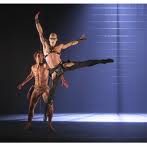Men In Tights! Lessons to be learnt from training for the performing arts.
Leave a CommentNick A llen is the clinical director of the Jerwood Centre, and looks after the dancers of the Birmingham Royal Ballet. His lecture was well structured, informative and entertaining. He gave an overview of the different aspects of dance training, the problems he encounters and some of the solutions.
llen is the clinical director of the Jerwood Centre, and looks after the dancers of the Birmingham Royal Ballet. His lecture was well structured, informative and entertaining. He gave an overview of the different aspects of dance training, the problems he encounters and some of the solutions.
Dancers are athletes
The dancers do 150 shows a year, about 8 shows a week when it is running. Their day might start with a 90 minute class, rehearsal in the afternoon, perform in the evening. They sometimes rehearse and perform different shows on the same day.
They train on a flat studio surface, with good force reduction properties. The stages are irregular in nature, with variations in force reduction properties, and it has a 4% rake (tilt) from back to front, to allow the audience to see all the dancers.
So they train and perform on two very different surfaces. Allen then went through some stats and ideas on how they have tried to bridge this gap through improving the home stage, but travelling is still problematic.
The impact is not helped by the fact that the dancers wear shoes that they proceed to batter to make them look better, and thereby negate any hope of having support in their footwear.
Wearing costumes also adds stress to the body, with some dancers losing 5kg of weight in each show, despite taking on 3 litres of fluid. Allen has been working with costume designers to try and make the costumes more breathable.
Injury management
 All this led into the type of injuries the dancers have: medial tibial stress syndrome (shin splints) is very common and the males have more thoracic back injuries (due to lifting females) and the females have more facet joint injuries in the lumbar spine. The ACL rupture protocol is for a 9 month rehab, which leads to stronger knees on return. Allen used to work in premiership rugby, where 6 month protocols were used, and this led to further injuries.
All this led into the type of injuries the dancers have: medial tibial stress syndrome (shin splints) is very common and the males have more thoracic back injuries (due to lifting females) and the females have more facet joint injuries in the lumbar spine. The ACL rupture protocol is for a 9 month rehab, which leads to stronger knees on return. Allen used to work in premiership rugby, where 6 month protocols were used, and this led to further injuries.
Allen then went through the training philosophy, which looked at building the foundations first. This involved 4 layers of “bricks”with the bottom being motor learning; the next layer being flexibility, strength and skill, the next layer being endurance and the top layer being performance. (I really liked this graphic and it makes a lot of sense to use something similar with all athletes).
Allen then compared the likelihood of injury between athletes and dancers at 2 different ends of a continuum. An athlete will have levels of strength and fitness, with less skill, so if they get a move wrong they can cope with it.
But get it wrong too often and then they will get injured. A dancer on the other hand will be very efficient at each move, but weak, so if they land or jump or lift out of place- they get injured.
Allen then described how he looks at the function of the movement, understanding the asymmetries within the dance. He looks at function over pathology, and efficiency of movement. He ended the lecture with an aside about bone health – 80% of the dancers have vitamin D deficiencies, some smoke, some are amenorrhoeic – which leads to more stress fractures.
Summary
A very informative lecture, which showed a sound methodology of analysis and training, together with some imagination and innovation. I will be following up on a lot of this information over the next couple of months.
You might like: are girls more flexible than boys?

